This little piggie went to market
Fridays are now my favourite day of the week, not only because it signals the beginning of the weekend, but because on Fridays I make the trip to the local Mayoreo Market to buy fresh fruit and vegetables. I will try to describe the sights, smells and sounds of this weekly adventure here.

Trip to Mayoreo Market
After a short twenty-minute drive in Tegucigalpa congested traffic, I park the car and leave it in the trusted hands of a parking guardian near the entrance to the Mayoreo Market. With Bea strapped snugly to my chest in the Tula baby carrier, I walk amongst the stalls laden with piles of colorful vegetables: carrots, zucchini, brocoli, cauliflower, aubergine, cabbage, lettuce, potatoes, tomatoes, yellow, white, green and purple onions, green, yellow and red peppers, slim celery stalks with tall leaves, green beans, snap peas, fresh parsley and cilantro, bright red-hot peppers tied in neat little fiery bunches. Picture a bustling market filled with stalls of fresh local produce, friendly vendors calling you “guapa” (pretty), “guera” (blonde), “jovencita” (young lady) quickly followed by “Que te puedo ofrecer?” (what can I offer you?) The “garlic man” walks briskly amongst the vegetable stands with bunches of garlic hanging from his shoulders and arms. He sells three different varieties of vampire chaser: Chinese, Nicaraguan and Honduran. I opt for the smaller- but local -Honduran variety for a fraction of the price.
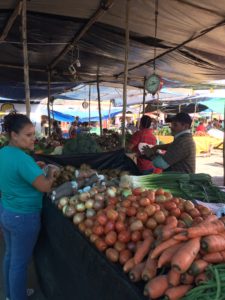
My carrier bags are soon very full and become too heavy to carry so we ask a man who works at the market for help. At this Mayoreo (wholesale) market, a handful of young men wander the market with handmade wooden wheelbarrow like carts and offer to follow us around in between the vegetable stalls while pushing our bags of goods all for a small donation. Matteo is very attentive and magically appears at our side to carry the heavy watermelon and place it gently beneath the fragile avocadoes in the wooden cart.
In the market, each vendor has a metal scale hanging from the rafters and expertly knows how many guavas or limes make up a pound. I’ve never been one to negotiate prices much. Sometimes, I choose to buy from the little old lady with wrinkles and a kind smile erstwhile thinking she should be at home resting and is well past retirement. Less often than not, I fall into the trap of guilt purchases when the calls of “Que quieres guapa?” grab my attention and a second too long of eye contact with the vendor in question makes it difficult to refuse a purchase. With time, I learn that the trick is to not look too interested and ask with a neutral look on your face: “Cuanto es?” Here in the Mayoreo, there are no signs displayed or fixed prices. The fruit is usually priced by weight or number as in 5 guavas for 20Lempiras (20L is the equivalent of 1$ Canadian.) The prices are much lower than in Canada and this is taking into consideration the inflation due to our foreign looks and my accent. With practice, I get to know the approximate price of things in the market and I’m getting better at choosing fruit that is not too green nor too ripe just by the smell and a gentle touch.

Once we have filled up on vegetables, we head over to the fruit section of the tarp covered market. Here the colors are even more vivid and contrasting: bright red strawberries, green limes, yellow bananas, oranges, watermelons, papayas, melons, pineapple, etc. Different vendors specialize in different fruits and they set up shop in the same corner of the market week after week. And I soon have my favourite stalls for certain fruits and vegetables. For example, there is an old lady with white hair and a frayed apron who sells papaya and watermelons. Her adult son offers me a taste of the fruit from the tip of his knife. The papaya is juicy and sweet tasting. I have learnt to ask for a ripe papaya “para hoy” and a green watermelon “para lunes” so we have a delicious selection of fruit to eat all week long. The man at the pineapple stand offers me a taste of his mouth-watering fruit from an old Tupperware container. He explains that there are smaller pineapples from the lake area of Lago Yajoa which are more acidic and are usually used to make juice. The larger sweeter pineapples are grown in la Ceiba on the Caribbean coast.
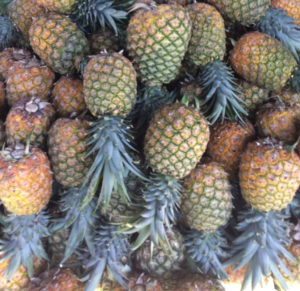
The vendors at the stalls on the outskirts of the market sell fresh flowers grown locally, fresh eggs (sometimes with feathers still stuck to the shell), milk and cheese products, handmade grocery bags made from old rice sacs and hand-woven plastic baskets. I bring my own reusable grocery bags but often have to insist on “No bag, please” since there is a tendency to provide plastic carrier bags for everything from green beans to huge watermelons. I try and do my bit for the planet and refuse plastic bags. On the other hand, since we cannot always trust the water and cleanliness of the produce, I soak and wash all the fruit and vegetables -of which we eat the skin or peel- in a few drops of special solution at home. Then, I usually cut and chop up the ripe fruit where it stays fresh in the fridge for at least a week. Now, when I have a craving for chocolate, chips or a cookie; I just open the fridge and grab a bowl of watermelon, papaya, or pineapple which is always on the ready.
Since Honduras is the original Banana Republic, it’s not surprising that there should be so many varieties of bananas and ways to eat them. Here, the regular ripe yellow banana is known as “banano.” I asked the lady behind the stall laden with several piles of monkey fruit in a range of sizes, about the difference between two piles of identical looking bananas. She explained that the pile of pale perfect looking ones was imported whereas the other pile of darker somewhat bruised ones was the local variety or “banana indio.” One step down, the “minimo indio” are sold in smaller markets and appear bashed and bruised from the outside but look and taste fine on the inside. (I suspect castoffs from the big exporters such as Dole and Chiquita which have a huge presence here.) I decided to go for the bananas in the “less pretty pile” which was also cheaper and they tasted just as good to me! (As the saying goes: “Don’t judge a banana by its cover.”)

This versatile fruit is not only eaten raw but can be cooked. There are “minimo verde” or green bananas which can be boiled in soup and taste more like potatoes. Green bananas can also be peeled, cut and fried in oil to make “tajadas” or banana chips. The extra large size bananas ones are called “platano macho” or plantain and taste pasty and dry raw but become delicious when peeled, sliced and fried in a little oil. “Platano frito” is served for breakfast, lunch and dinner. It’s so sweet and greasy that I personally view it more as a desert. And the list goes on; “butuco” are what my husband calls the “stubby bananas” since they are short and fat. The very little ones, called “dactiles,” are even sweeter that the regular Dole or Chiquita variety and T calls them “baby bananas like my baby sister B.”
One can buy a “mano” or hand of eight or 10 bananas at the market. In the fields on the banana plantations near the Caribbean coast each banana tree held a bunch of 50 or so bananas covered in a blue plastic. Each tree produces a bunch of bananas that must be carefully wrapped in a plastic bag (while still hanging from the tree) in order to protect the fruit from the changes in temperature and insects or plagues until ready for harvest. As I gazed out at the endless sea of bananas dotted with blue plastic bags, I could only imagine the arduous physical task of having to toil under the sweltering sun in order to protect this yellow jewel: bananas.

Central America is plentiful with exotic fruits which we don’t get to see in faraway Canada since the time of maturation between “picked” and “ripe” is very short. Some examples are: lychees (also called rambutan), starfruit, mangosteen, zapote, granadilla, coconut, guava (green Chinese imported variety and small yellow ones with bright pink flesh), guanabana, papaya, passion fruit, mangoes (large orange red ones and smaller yellow ones which are surprisingly sweeter.) There is a middle-aged man at one of the stalls who sells unusual fruits and he is always happy to oblige me by patiently answering my list of questions: “What is this called?”, “How do we eat it?”, “How does it taste?” During the tasting session, we discover new produce to add to our list of local favourites. Other times, the item in question is relegated to the history books of my palate (which may be in part why there is not a huge market for their exportation up north.) Certain fruits are used to make fresh juice such as: orange, passion fruit, starfruit, guava, tamarindo, nance, watermelon, and limes. We also make scrumptious smoothies with the ripened fruit, the combinations of which are endless: celery orange, banana papaya, strawberry banana, coco lime, passion fruit clementine, just to name a few. I don’t buy box juice anymore since we can squeeze our own and at the same time avoid drinking preservatives and added sugar. Each week, I discover something new to bring home and taste.

These days, our daughter, who is 18 months old, does not ask for peaches, pears and plums but “pina,” “sandia” and “mas papaya;” her three favourite fruits at the moment. I fear we’ve trained her taste buds on fresh local produce and are setting ourselves up for trouble when we return home to Canada (the country of apples and pears.) The fruit that we purchase directly from the farmer at the market lasts much longer and is fresher than what we buy at the grocery store here in the city. The Mayoreo Market in Tegucigalpa is the Central American version of the hip Farm to Table movement. In conclusion, I especially like the trip to market since it presents a lovely, colorful and tasty experience which contrasts with the often negative news headlines for which our adopted country is known.
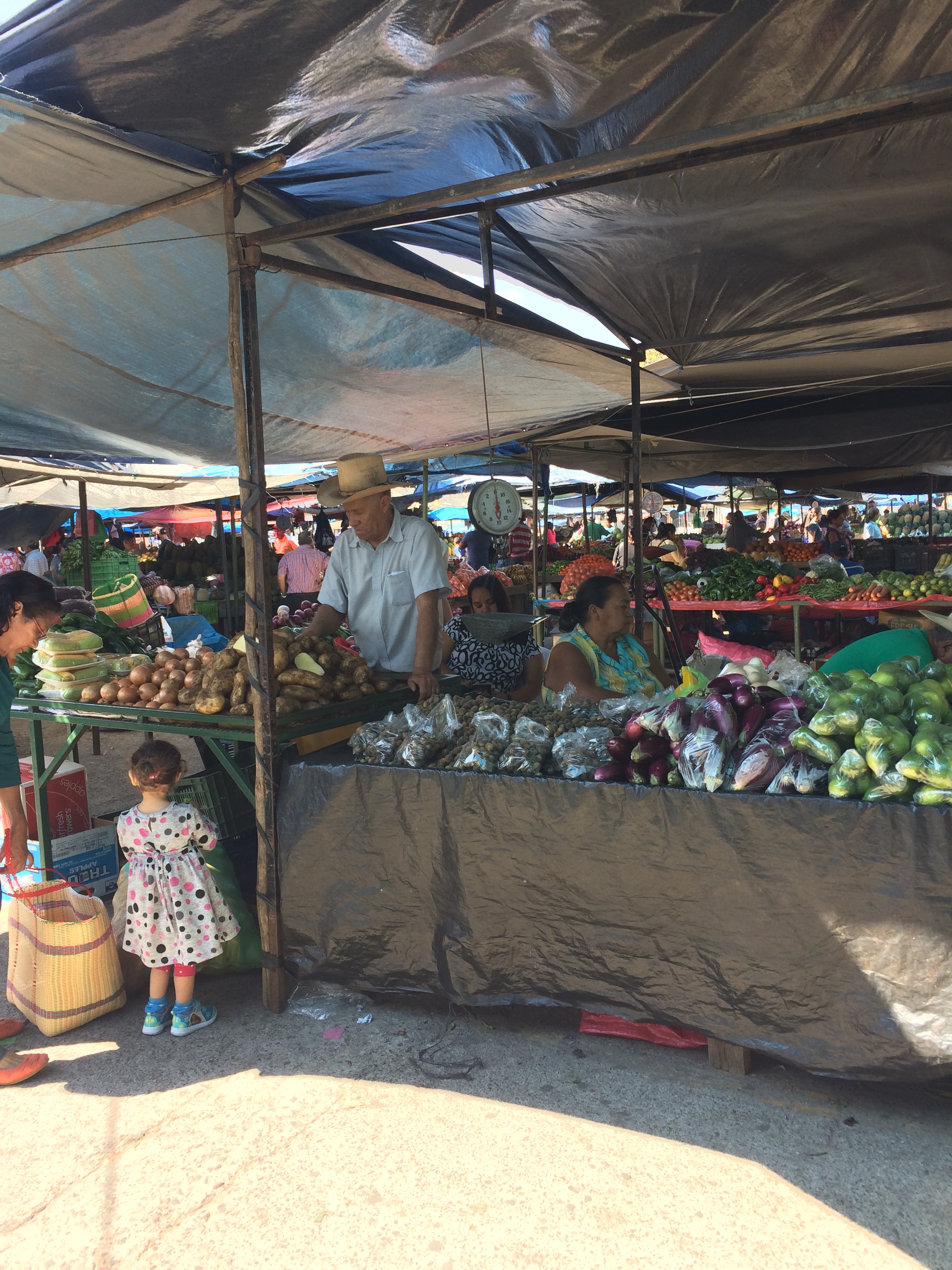
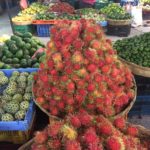
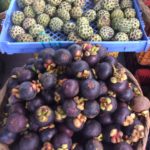
Great to read about your experiences of this great market – and such a variety of available items. Enjoy!
Scrumptious fruit and vegetables very well written but what about the carne y pescado ?
Another great article with beautiful pictures! Makes me hungry! Xx